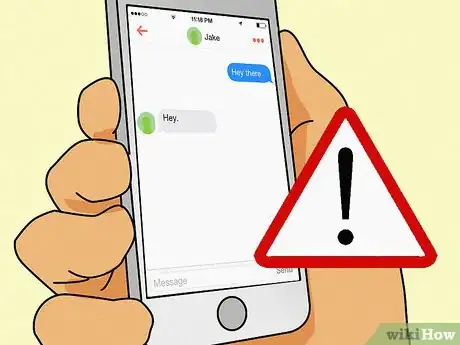This article was co-authored by Maya Diamond, MA. Maya Diamond is a Dating and Relationship Coach in Berkeley, CA. She has 13 years of experience helping singles stuck in frustrating dating patterns find internal security, heal their past, and create healthy, loving, and lasting partnerships. She received her Master's in Somatic Psychology from the California Institute of Integral Studies in 2009.
There are 12 references cited in this article, which can be found at the bottom of the page.
This article has been viewed 121,166 times.
Tinder is a widely popular phone application for making new romantic connections with people. Unfortunately, this has led to spam bots and money-hungry scammers uploading fake profiles in an attempt to take advantage of users. However, if you remain wary of your actions, you can keep yourself safe. By reverse searching any pictures and phone numbers, avoiding suspicious profiles and links, protecting your personal information, and refusing to give out money, you can spot scams and spam on Tinder.
Steps
Spotting Fake Profiles
-
1Avoid profiles with weird links in the biographies. Some profiles will direct you to click on a link. Beware of any profiles that say, for example, “if you want to learn more about me” or “check out my website.” If the URL looks shortened, it most likely leads to a scam site.
- While some profiles may offer legitimate links, never click on a link if you feel unsure.
-
2Watch out for profiles with one photo or glamor shots. Profiles with one photo, especially when accompanying bios devoid of key details such as occupation and education, are red flags. Also avoid profiles that depend on professional-looking photos, photos that look edited, or photos of celebrities. Skip profiles that confuse you with many photos of different people. Finally, always pass on profiles that try to lure you with scantily-clad, perfect-looking bodies.[1]
- For example, many spam bots rely on women in suggestive poses wearing bikinis or underwear. Male-themed profiles may show shirtless men with well-chiseled abs.
- Scammers are refining their bots, so a spam profile may hide behind an image of a cute girl or boy you’d find next door. If the person looks like a model, it’s probably too good to be true.[2]
Advertisement -
3Check to see if you have friends and interests in common. Tinder’s algorithm attempts to match you with people nearby based on friends and interests you have added to Facebook. When you get matched with a profile that shares nothing in common with you, it is likely a spam bot that didn’t add interests to Facebook.[3]
Recognizing Spams and Scams through Interaction
-
1Distrust fast replies. Many spam bots will send you a message as soon as you are matched with them. This is to lure you in quickly. Even if this doesn’t happen, consider the speed of messages. Do any come faster than a real person should be able to type? If so, it is a spam bot.[4]
- Some spam bots may now be programmed to time their responses. Monitor future messages for inconsistencies, such as for responses that seem generic rather than tailored to your conversation, those that sound nonsensical, and those with poor grammar and spelling.
- One way to test for bots is to send a nonsense message. Type a bunch of random letters like “agdsgdgdf.” Bots will respond to it as if it is a normal message.
-
2Be suspicious of conversations that quickly become suggestive. Most people won’t jump to racy talk when speaking with a stranger through Tinder. Bots however will quickly escalate the conversation such as by suggesting you may get a phone number if you “play with them” or through other sexually charged messages.[5]
-
3Back out when they immediately want to leave the app. Soon enough, the bot will ask you to go somewhere else. They’ll give you a link, saying that they want to leave Tinder or talk to you in private on another site. Do not click any link they show you. If you do, do not give up your credit card information.[6]
- Some scams will send you a phone number. Don’t give out your phone number or other personal information. Search the phone number through a reverse phone lookup if you are unsure about its legitimacy.[7]
- Look out also for quickly-sent links where the spammer tells you something along the lines of “you’ve got to check this out” or “you won’t believe this.” Often, they don’t explain the unsolicited link, but they may also talk about an amazing application, video, or product. Don’t even look at these.[8]
-
4Be aware of how many questions they ask you. Real scammers on Tinder will try to solidify a connection with you. They will ask you lots of questions about yourself, particularly about past relationships and your financial situation. They won’t want to tell you lots of details about themselves, and if they do, look out for any inconsistencies.[9]
- Never give out significant personal information when getting to know someone on Tinder.
- As you progress, be alert during all your interactions. Once you build trust, look for scam signs, such as the person making excuses not to meet you, not having new photos to send, or requests for money.[10]
Protecting Yourself from Scams
-
1Perform a Google search on images. Create a screenshot of a person’s picture using your phone, then go to CTRLQ.org. Click the “upload picture” button to reverse search the image. This may link you to the location where the image was taken from, such as Facebook or a cam site, revealing telltale signs such as the person's name differing between accounts.[11]
- CTRLQ.org doesn’t always work as well as directly searching from Google. To do this, you will have to send the picture to your computer by connecting your phone through USB, e-mailing it, or storing it in a service such as Microsoft OneDrive or Google Drive. Retrieve the image, then go to the image tab on Google’s search engine. Click the camera icon in the search box.
- Screenshots on Android are done by holding down the power and volume-down buttons at the same time. On Apple products, hold the Sleep button near the top of the device, then press the home button at the bottom of the device.[12]
-
2Never send money. Spam bots will entice you to sign up for a website, whereas scammers will ask you to send money to help them out of a bad situation, such as car or family trouble. As soon as you are asked for money, cut off all contact.[13]
- This includes never putting your credit card into linked cam sites or information lookup sites. Perform your own searches on the person through Google and, when using reverse phone lookup, stop once you get the phone number’s area of origin for free.
-
3Be protective of your personal information. Some spammers and scammers will ask you for sensitive information. Besides social security, credit card, and bank information, don’t give out your work and home addresses. Also, don’t give out your phone number to someone you don’t trust.[14]
- For example, a scammer may ask for your address to send you a gift and others will ask questions early on about how much money you make or where you bank to get a sense of how much of a target you are. Scam websites ask for your credit card and other personal information.
- Some spam bots will give you a phone number early on to build trust. Remember to check it online for legitimacy. Don't give out your phone number until you feel safe, since it can be used to sign you up for spam.
-
4Reverse lookup a phone number. When someone gives you a number, research it. You can Google search it to see if the area code matches your area. Also, go online to sites such as Whitepages or Reverse Phone Lookup. Type in the number and it will give you some information, such as the location of the phone.[15]
- Lookup sites offer full reports for a small fee, but this offer isn’t recommended. You will get enough information from a standard search without sharing your credit card.
Expert Q&A
Did you know you can get expert answers for this article?
Unlock expert answers by supporting wikiHow
-
QuestionHow can you tell if someone is trying to scam you online?
 Maya Diamond, MAMaya Diamond is a Dating and Relationship Coach in Berkeley, CA. She has 13 years of experience helping singles stuck in frustrating dating patterns find internal security, heal their past, and create healthy, loving, and lasting partnerships. She received her Master's in Somatic Psychology from the California Institute of Integral Studies in 2009.
Maya Diamond, MAMaya Diamond is a Dating and Relationship Coach in Berkeley, CA. She has 13 years of experience helping singles stuck in frustrating dating patterns find internal security, heal their past, and create healthy, loving, and lasting partnerships. She received her Master's in Somatic Psychology from the California Institute of Integral Studies in 2009.
Relationship Coach If they're asking for money at any point, that's a big sign you're being scammed. Another common sign is if the person you're talking to says "I love you" before you've really established a genuine connection. Also, if you've been talking to someone for a few weeks or months and they don't want to meet up in person, it's probably a scam.
If they're asking for money at any point, that's a big sign you're being scammed. Another common sign is if the person you're talking to says "I love you" before you've really established a genuine connection. Also, if you've been talking to someone for a few weeks or months and they don't want to meet up in person, it's probably a scam.
Warnings
- Never hand out personal information, including addresses, bank information, and phone numbers.⧼thumbs_response⧽
References
- ↑ http://lifehacker.com/how-to-tell-if-a-tinder-profile-is-fake-1772999305
- ↑ http://www.bbb.org/council/news-events/bbb-scam-alerts/2015/07/scam-alert-how-to-spot-spam-profiles-on-tinder/
- ↑ http://www.huffingtonpost.com/2013/07/11/fake-tinder-profiles_n_3580926.html
- ↑ http://lifehacker.com/how-to-tell-if-a-tinder-profile-is-fake-1772999305
- ↑ https://www.phone.instantcheckmate.com/dialed-in/tinder-bot/
- ↑ http://mashable.com/2013/07/12/tinder-scam/#yoSlWJ3j5uqj
- ↑ https://mic.com/articles/149692/new-tinder-scam-promises-verified-accounts-steals-money#.1jBOhihSz
- ↑ http://www.bbb.org/council/news-events/bbb-scam-alerts/2015/07/scam-alert-how-to-spot-spam-profiles-on-tinder/
- ↑ http://www.businessinsider.com/how-to-spot-dating-site-scammers-on-okcupid-and-tinder-2015-7?r=UK&IR=T
- ↑ http://www.businessinsider.com/how-to-spot-dating-site-scammers-on-okcupid-and-tinder-2015-7?r=UK&IR=T
- ↑ https://www.propublica.org/article/the-dig-how-to-background-your-tinder-dates
- ↑ https://support.apple.com/en-us/HT200289
- ↑ Maya Diamond, MA. Relationship Coach. Expert Interview. 17 January 2019.
- ↑ https://www.gotinder.com/safety
- ↑ http://www.cbsnews.com/news/reverse-cell-phone-lookup-service-is-free-and-simple/
- ↑ Maya Diamond, MA. Relationship Coach. Expert Interview. 17 January 2019.
About This Article
While scam and spam accounts can pop up on Tinder, you can protect yourself from them by recognizing suspicious profiles and messaging behaviors. The easiest way to tell an account is fake is if there is a weird link in their profile or they ask you to visit a website. Additionally, be wary of profiles that only have 1 photo or mostly professional-looking pictures to make them seem like a model or celebrity. While messaging, avoid accounts that contact you instantly after matching, as it's probably a spam bot. You should also be suspicious if the conversation gets racy quickly, especially if they give you a phone number to text. For more tips, like how to find out if a profile picture is legitimate, read on.






































































